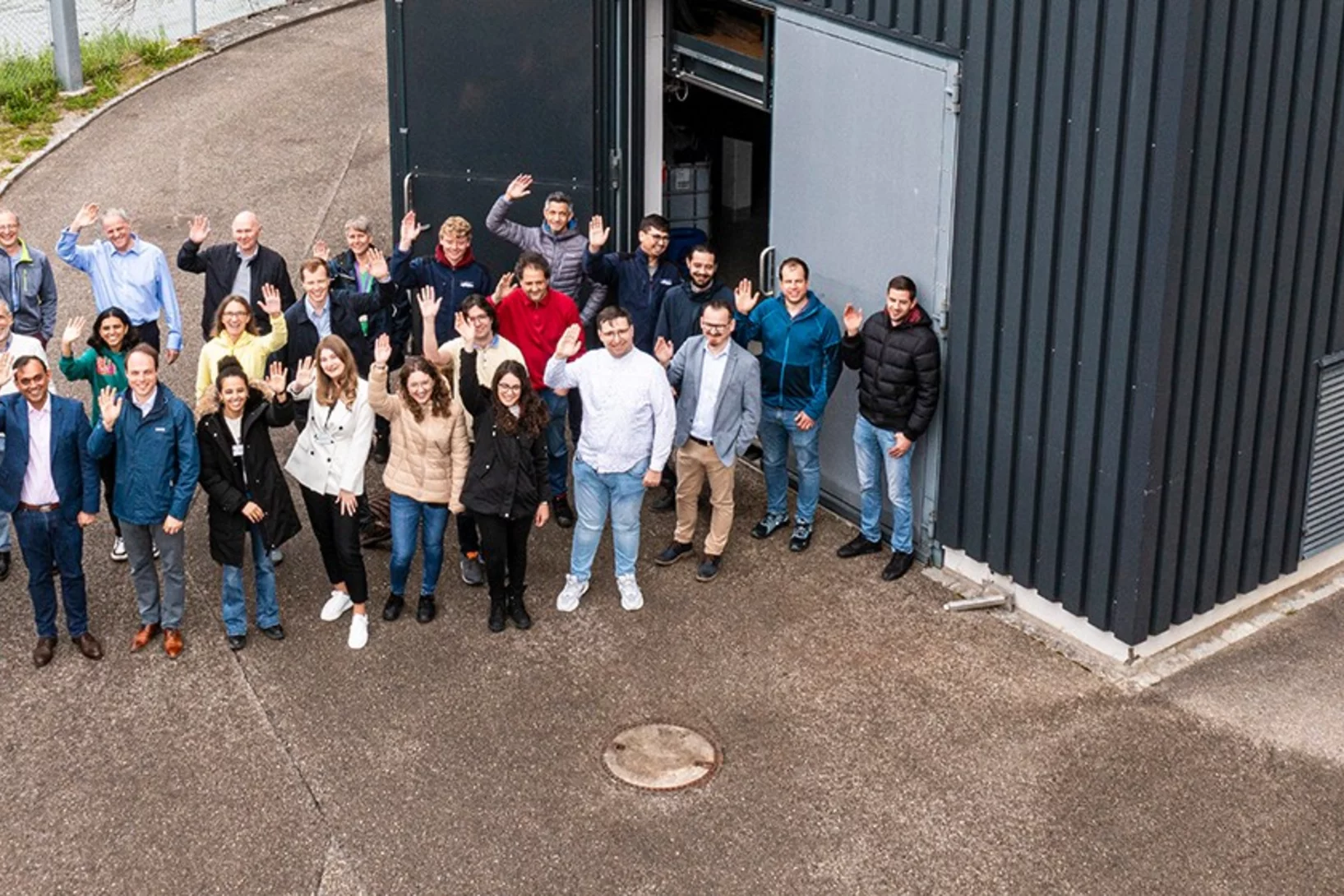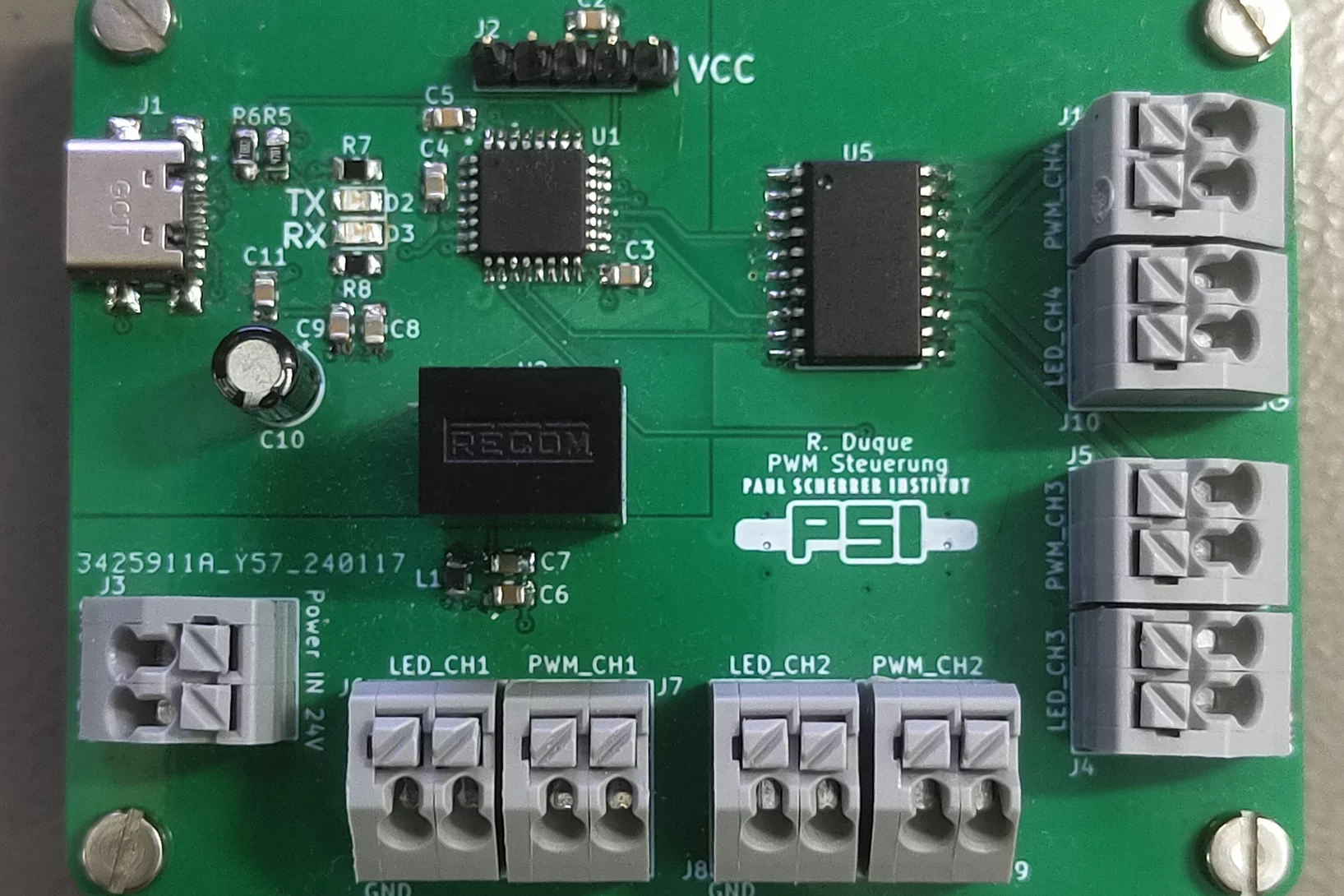Researchers at the Paul Scherrer Institute PSI are looking for answers to essential questions concerning the underlying structures of matter and the fundamental principles of nature. They study the composition and properties of elementary particles – the smallest building blocks of matter – or investigate the structure of biological molecules and how they perform their function. The knowledge gathered in this way opens up new approaches to finding solutions in science, medicine and technology.
Find out more at Overview Fundamentals of Nature
Beam test of the scintillating fibres at MAMI un Mainz
The Mu3e scintillating fibre detector was tested using the electron beam of MAMI at the institute of nuclear physics in Mainz. The MuPix pixel detectors were used as a refernce.
PSI day-care centre returns to the campus
The new building is ready. From the beginning of August 2024, PSI children are once again being looked after on campus.
Sources of smog in Beijing identified
Researchers at PSI are investigating the wide range of causes underlying smog in Beijing.
Move the soft mode by electric fields in quantum paraelectric SrTiO3
PSI Researcher used inelastic neutron scattering to show how collective lattice vibrations can be controlled by electric fields. These results indicate that different eigenmodes can couple in field in this incipient ferroelectric.
Book on neutron imaging
A new book on neutron imaging was recently published, written by editors and contributors from LNS. The book has a focus on applications and covers hard and soft matter.
‘What can I do?’ vs ‘What do I want to do?’
‘Which jobs can I apply for with my background in X, or which companies are looking for this background?’ is a question that comes up in career counseling every now and then. Clearly, having to find a job that fits is a big choice. What makes it even harder, is that many competencies that are important requirements for a future job are just taken for granted in academia.
PSI and Metafuels: Pioneers for Sustainable Aviation Fuel
PSI focuses on sustainable aviation: In collaboration with the climate start-up Metafuels, PSI is developing the aerobrew technology to produce sustainable aviation fuel (eSAF) from renewable energy sources.
Lehrlingsevent Gewerbeverein 2024
Trotz EM waren viele an diesem grossartigen Anlass dabei!
New X-ray world record: Looking inside a microchip with 4 nanometre precision
Researchers at PSI have succeeded in imaging the spatial structure of a computer chip with a record resolution of 4 nanometres using X-rays.
Move the soft mode by electric fields in quantum paraelectric SrTiO3
PSI Researcher used inelastic neutron scattering to show how collective lattice vibrations can be controlled by electric fields. These results indicate that different eigenmodes can couple in field in this incipient ferroelectric.
Uniquely precise: New value for the half-life of samarium-146
Researchers at PSI and the Australian National University have re-determined the half-life of samarium-146 with great precision.
Sustainable aviation fuel from the PSI campus
In collaboration with climate start-up Metafuels, a pilot plant for the production of sustainable aviation fuel is being set up on the PSI campus.
Conventional superconductivity in the doped kagome superconductor Cs(V0.86Ta0.14)3Sb5 from vortex lattice studies
A hallmark of unconventional superconductors is a complex electronic phase diagram where intertwined orders of charge-spin-lattice degrees of freedom compete and coexist. While the kagome metals such as CsV3Sb5 also exhibit complex behavior, involving coexisting charge density wave order and superconductivity, much is unclear about the microscopic origin of the superconducting pairing. We study the vortex lattice in the superconducting state of Cs(V0.86Ta0.14)3Sb5, where the Ta-doping suppresses charge order and enhances superconductivity. Using small-angle neutron scattering ...
Digitalisation: a blessing for the energy transformation
Researchers at PSI have calculated the influence of digitalisation on energy consumption.
Swiss Technology Award
As part of the annual Swiss Innovation Platform "open-i" in Zurich in November, the "Swiss Technology Award" will once again be presented this year in three categories.
Nanoimaging Reveals Topological Textures in Nanoscale Crystalline Networks
X-ray nano-tomography reveals collective behavior in synthetic self-assembled nanostructures. The new method opens opportunities for the synthesis of photonic and plasmonic materials with improved long-range ordering.
Breast cancer classification using AI
Researchers at PSI and MIT are developing a new approach, which combines imaging and artificial intelligence to improve the staging of breast cancer.
Feriencamp 2024
Spannende Aktivitäten + Experimente = PSI-Feriencamp
Mealplanner - Wo wird unser Mittagessen festgelegt?
Eine Applikation, ohne welche wir nicht wüssten, was es denn heute zum Mittagessen gibt.
Fourth Data Challenge
The Mu3e data challenges aim at establishing the data processing and storage procedures as well as the online monitoring tools. To this end, we use simulated data to test all involved systems and further develop the code. In the forth edition, we aimed at incorporating the farm FPGAs, GPU selection and advanced subdetector monitoring tools.
Abschlussfeiern an den Berufs- und Berufsmaturitätsschulen 2024
Die erfolgreichen Abschlüsse wurden an den Berufs- und Berufsmaturitätsschulen gefeiert. Wir sind stolz auf unsere Lernenden und ihre tollen Leistungen!
Protein droplets likely don’t cause Parkinson’s
Study deepens our understanding of neurodegenerative diseases linked to protein aggregation.
Heizungsteuerung 2024
Neue Steuerung für Chemie-Experimente
Installation of the first two front ends for the SLS2.0 completed
At the Swiss Light Source SLS of the Paul Scherrer Institute, another important step has been taken towards the completion of the SLS 2.0 upgrade project.
Insights into the superior oxygen evolution reaction activity of CoOx/CeO2 composite electrocatalyst
CeO2 significantly enhances the oxygen evolution reaction (OER) activity of CoOx, although the mechanism behind this synergy is still unclear. Here, operando hard X-ray absorption spectroscopy (hXAS) is applied to monitor the Co-K edge and Ce L3 edge in CoOx/CeO2 to shed light on the evolution of Co and Ce oxidation states during OER. In addition, ex situ soft XAS (sXAS) characterizations provide information on the irreversible surface-specific transformations of the Co L3 edge as well as the O K edge.
PSI-UCL-Surrey workshop on silicon and germanium based quantum devices
A team of PSI scientists as well as collaborators from UCL and the University of Surrey met at the Fondazione Monte Verità to discuss results and trace the roadmap for future research into quantum devices based on silicon and germanium.
Proxima Fusion moves to Park Innovaare
Proxima Fusion and the Paul Scherrer Institute (PSI) have signed a framework agreement to develop high-temperature superconductor magnet technology (HTS).
Joining forces to cure children
The close collaboration between PSI and the University Children’s Hospital Zurich for the benefit of children with cancer began 20 years ago.
Do you want to use the summer break to advance your career?
Are you wondering what you can do over the summer to enhance your career prospects and improve your employability? Look no further, this blog post has some ideas to spark your curiosity, motivation and enthusiasm, and advance your career at the same time:
Lehrberufe à la Carte 2024
700 Personen besuchten Berufsbildungsevent des PSI Paul Scherrer Instituts





























